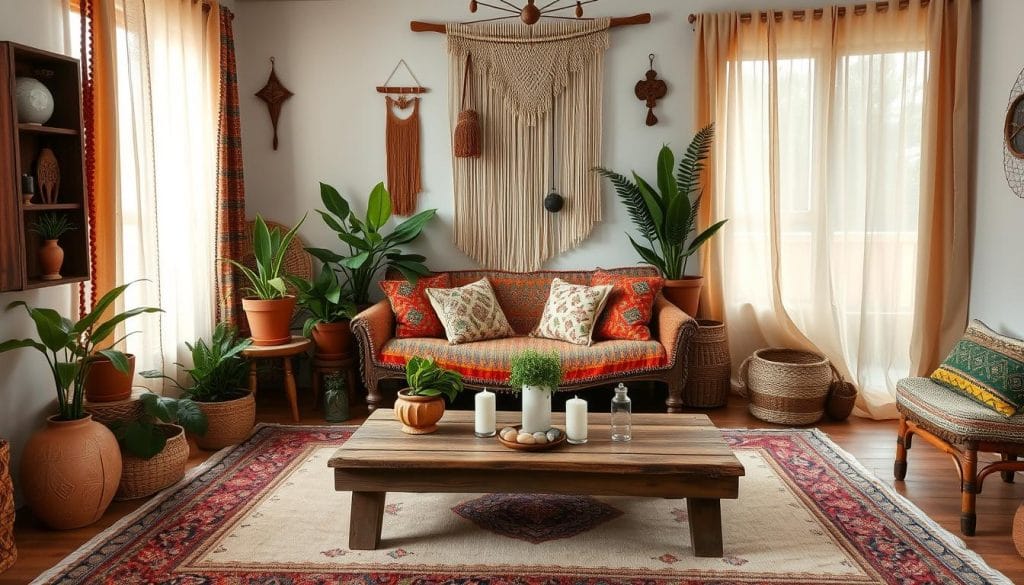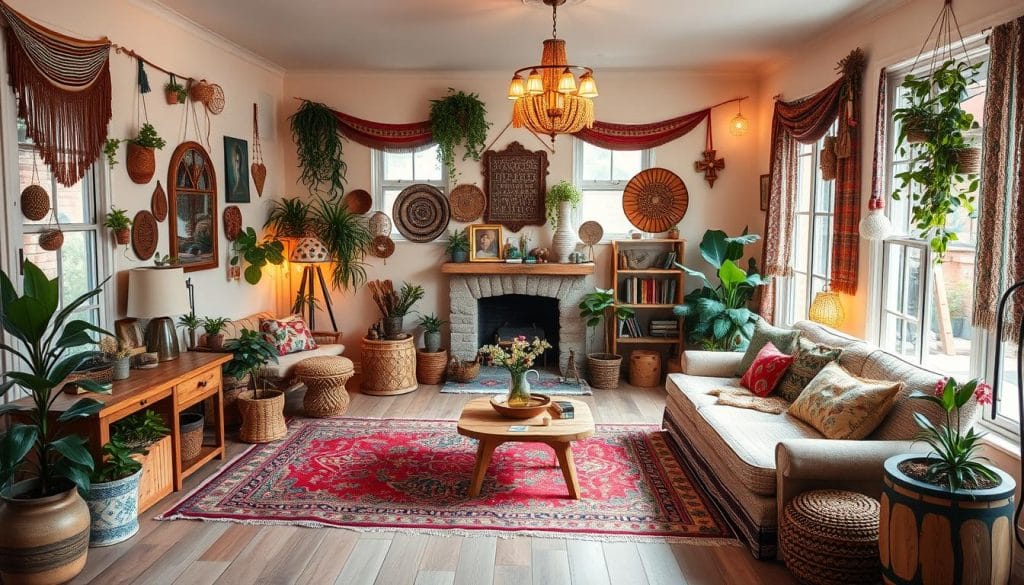Have you ever entered a space and felt calm right away? ✨ That calm likely came from mixing natural stuff with modern looks. This style is simple, with minimalist features and nature’s raw beauty. Let’s learn about 10 key parts of organic interior design. Our goal is to help you make a balanced home design. A place where every corner is filled with peace and style.
Picture a room with cozy wooden furniture, timeless marble, and soft fabrics. These things make you want to reach out and touch them. They use a neutral color palette with earthy tones, greens, and browns. This is the core of modern home aesthetics. But it’s more than looks; it’s about feeling a true connection to your space. It brings balance and harmony to your living area.
Organic modern design mixes indoor plants that clean the air with eco-friendly choices. Click here to learn more. Let’s make your home a place of modern beauty and natural peace. 🌿
Understanding Organic Modern Design
Welcome to organic modern design. It’s where nature’s beauty and modern sleekness combine. It’s about merging natural chaos with modern simplicity and use.
The Concept of Organic Modernism
Organic modernism mixes natural and modern to craft cozy beauty. Picture warm woods, stone, and clean lines together. It’s creating minimalist, nature-filled spaces.
Historical Influence on Modern Design
This style’s roots go back to mid-20th century modernism. It values form and function, leading to organic interiors. It’s simplicity and clutter-free living with warmth.
Interest in this design is growing, shown by 9,013 shares on related articles. We’ve turned a 9,000 sq foot area into an organic haven. Working with Amazon, CB2, West Elm, and others, we offer top modern and natural items.
| Feature | Description | Example |
|---|---|---|
| Material Choice | Natural finishes and sustainable elements | Unlacquered brass fixtures, dark walnut |
| Color Palette | Creamy beiges, soft whites, serene blues | Stone backsplash, updated oak flooring |
| Furniture Selection | Functional and stylish pieces | Walnut sideboard, Art Deco brass detailing |
| Biophilic Elements | Indoor plants and natural light | 10-foot olive trees, open windows |
In conclusion, organic modern design brings the outdoors in. It’s about making spaces both natural and modern. Let’s make your home serene together! 📸✨
Natural Materials for Authenticity
Organic Modern Design is all about natural materials. They make your space warm and earthy. Sustainable wood and timeless stone are very important. They make your home look beautiful and feel welcoming.
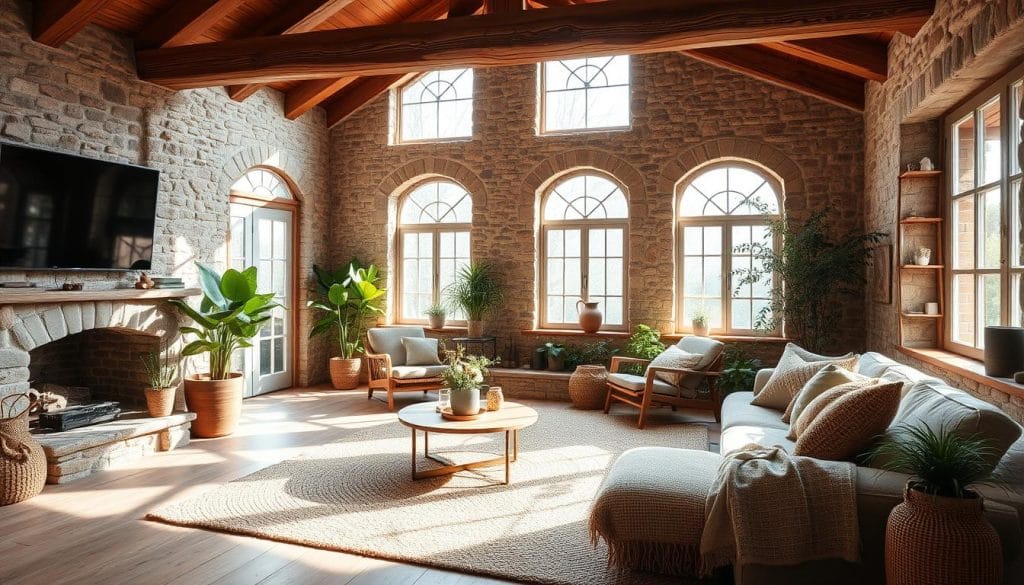
Wood Choices for Warmth
Choose sustainable wood for a warm interior. Reclaimed wood brings history and uniqueness. Oak, walnut, and maple are great for their strength and beauty. They make your home cozy and lovely.
Wood’s imperfections, like knots and grain, add real beauty. They make the design feel more authentic.
Stone as a Timeless Element
Stone is also key in Organic Modern Design. It’s strong and connects us to nature. Marble, granite, and limestone add lasting beauty. They’re durable and a great choice for your home.
Using stone in your design keeps your space looking great. Its natural color and texture changes make your home exciting. Your space will always feel new and welcoming.
A Neutral Color Palette for Serenity
Creating a tranquil space starts with color choice. We focus on neutral interiors, finding earthy tones key. Colors like gray, beige, and taupe set a calm background. They blend well with natural materials, making any room peaceful.
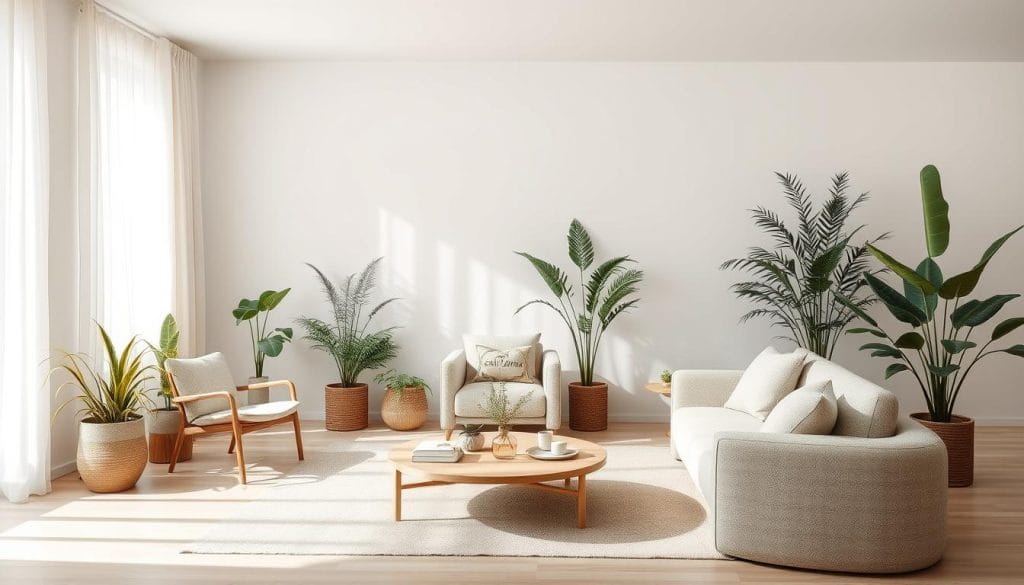
The Power of Earthy Tones
Earthy tones are vital for serenity in design. Olive greens, sandy browns, and muted blues reflect outdoor peace inside. These colors are not just pretty. They bring a soothing vibe, perfect for relaxation. Nature-inspired elements make our spaces more calming.
Accents and Pops of Color
A neutral palette needs accents to sparkle. Add color with a bold olive wall or a navy pillow. These choices keep neutrals from feeling dull. They make the space welcoming and show off your style. Adding soft blankets and lush rugs brings comfort and warmth.
Textures That Invite Touch
Organic modern design is about looks and feels. Using tactile design elements can make a space cosy and inviting. Soft fabrics and hard surfaces blend easily in this style.
Incorporating Soft Fabrics
Soft fabrics make any place warm and luxurious. Wool, linen, and cotton add warmth and comfort. Picture sinking into a plush linen sofa or wrapping in a cozy wool throw. It feels like home. Organic cotton and responsibly-sourced wool are top choices. They’re good for the planet too.

Mixing Hard and Soft Surfaces
This design balances soft and hard elements. Imagine a wool rug on a sleek stone floor. It’s a blend that feels good and looks good. This mix boosts visual appeal and invites touch. It creates a place that’s nice to see and touch.
Experts offer more advice on sustainable interior design. Adding textures and tactile elements makes your home stylish and comfy. Whether fixing up the living room or starting fresh, these tips help.
Open Spaces for Flow and Light
In Organic Modern homes, open floor plans make us feel free and let in lots of light. These spaces let things flow together, making a welcoming place. They make your home look bigger and make you feel better overall.
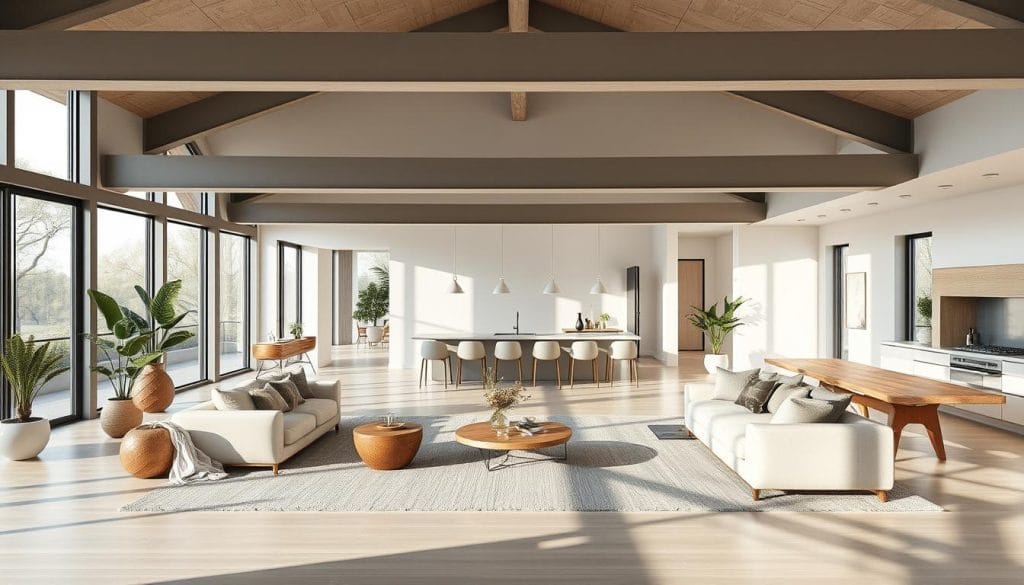
Benefits of Open Floor Plans
Open floor plans take away unneeded walls. This lets areas flow into one another easily. It’s perfect for big parties or quiet family times.
With no walls blocking it, sunlight fills every corner. This means less need for fake light and a cozy glow everywhere.
Creating Zones Without Walls
You can still have your own special spots without walls. Place furniture and use rugs and lights smartly to set zones apart. You can have dining, lounging, and work areas that look good together.
Here’s a quick look at the advantages:
| Advantages | Details |
|---|---|
| Enhanced Flow | Seamless transition enhances connectivity between spaces. |
| Increased Light | More natural light penetrates, reducing artificial light dependency. |
| Flexible Use | Easy to reconfigure for different activities and gatherings. |
| Improved Airiness | Creates a feeling of spaciousness and openness. |
With these ideas, you can make your home a light-filled, open space that’s still cozy. Let your imagination run wild and see your home become a brighter, welcoming place.
Biophilic Design: Bringing Nature Inside
Organic Modern Design includes essential biophilic design principles. By adding nature inside our homes, we create better spaces. These spaces aren’t just nice to look at. They also improve air quality and give us more natural light. This makes for healthier living.
Indoor Plants for Air Quality
Adding indoor plants helps embrace biophilic design and better air quality. Being around houseplants lowers stress and blood pressure. They look good and work as natural filters too. By using plants, indoor air quality can go up by 50%. It’s good for both style and health! 🌿
Natural Light and Its Impact
Using natural light at home can make you feel better. It reduces stress and boosts well-being. Big windows and skylights are key to get more natural light. They cut the need for electric lights by 45%. This saves energy and makes living spaces brighter and more lively.
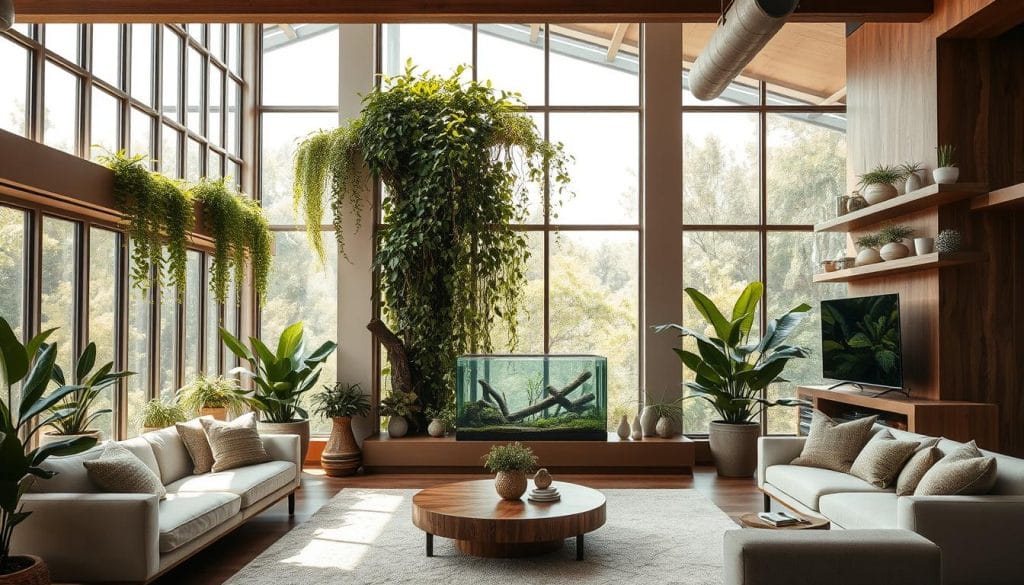
Dynamic lighting is also important. It changes warmth and light level to fit our daily rhythm. These choices make your home prettier and connect you with nature. They bring peace and encourage eco-friendly living.
| Biophilic Elements | Benefits |
|---|---|
| Indoor Plants | Air purification, stress reduction, improved aesthetics |
| Natural Light | Mood enhancement, energy savings, improved well-being |
| Living Walls | Air quality improvement, aesthetic appeal, tranquility |
| Large Windows | Better natural light access, connection to the outdoors, energy savings |
Using biophilic design at home is more than a trend. It’s about making a space that keeps us healthy and close to nature. Let’s use these elements to turn our homes into places that care for our body and mind.
Sustainable Practices in Home Design
Home design today is more than trends—it’s about necessity. We see homes cause 30% of global greenhouse gas emissions. So, we must make homes sustainable to decrease our environmental mark. Let’s see how eco-friendly materials and energy efficiency can help.
Eco-Friendly Materials and Choices
Choosing eco-friendly materials is key in sustainable design. These materials reduce your carbon footprint and improve your health. Bamboo and reclaimed wood are great for floors and cabinets. They last long and add beauty. Recycled countertops and metals also help, showing we’re turning green in building.
Local materials cut down on shipping, which is good for the planet. Low-VOC products make indoor air fresher and healthier. We believe in using natural stuff as much as possible. It makes homes feel real and connects us to nature.
The Importance of Energy Efficiency
Energy efficiency is central to green design. It’s about using less energy while staying comfortable. Insulation is critical here. High R-value insulation cuts your energy use. Stopping air leaks is also crucial for keeping your home’s temperature stable.
Right doors and windows help save energy. Energy Star appliances and LED lights reduce bills and are good for Earth. Choosing these makes your home modern and efficient.
| Sustainable Practices | Benefits |
|---|---|
| Use of Recycled Materials | Reduces waste and conserves natural resources |
| High R-Value Insulation | Improves energy efficiency & reduces heating/cooling costs |
| Energy Star-rated Appliances | Lower energy consumption & utility bills |
| LED Lighting | Saves energy & lasts longer |
| Low-VOC Paint | Enhances indoor air quality |
| Local Materials Usage | Minimizes transportation-related emissions |
Using these sustainable practices in home design helps the planet and makes our lives better. Let’s choose a green future together!
Functional Furniture for Balance
Getting the right balance at home means using furniture that serves more than one purpose. It’s about choosing designs that look good and work well in your space. Such items are vital for a home that blends beauty with usefulness.
Multi-Use Pieces
Flexible furniture can change how you use your home. Imagine a sofa that also is a bed for guests. Or a table that grows for parties. These save space and make your home more useful.
Choosing Ergonomic Designs
Working from home makes comfort key. Choose chairs that support your back and desks that adjust in height. This furniture helps you stay healthy and comfortable at home.
| Type of Furniture | Function | Organic Modern Appeal |
|---|---|---|
| Modular Sofa | Seating/Guest Bed | Warm tones, sustainable fabrics |
| Extendable Dining Table | Additional Seating | Natural wood finishes |
| Ergonomic Chair | Improved Posture | Minimalist design, comfortable materials |
| Adjustable Desk | Height Variability | Eco-friendly materials, sleek design |
Personalized Decor: Reflecting Your Style
Organic Modern Design says your home should feel like part of you. It’s about making your space unique with personalized decor. You can use special artwork or collections to tell your story.
Art and Personal Touches
Art in your home does more than look good; it tells your story. Personalized home decor like gallery walls or family photos makes your space special. It shows who you are and brings warmth.
Imagine mixing modern sculptures with vintage finds. This mix creates a look that’s both nostalgic and modern. It makes your home truly reflect you.
Handmade Versus Mass-Produced Items
In today’s fast-moving world, choosing artisanal items stands out. Handmade pieces, crafted locally or for you, feel more special. They offer something unique that big stores can’t.
Picking handcrafted decor supports craftspeople and adds depth to your home. These pieces are unique and add a personal touch. Choosing them makes your space feel carefully put together.
| Feature | Handmade | Mass-Produced |
|---|---|---|
| Uniqueness | High—Each piece has distinct qualities | Low—Identical items |
| Craftsmanship | Exceptional—Attention to detail | Variable—Dependent on factory standards |
| Personal Connection | Strong—Often involves a story or personal touch | Weak—Generic items with no backstory |
Choosing personalized decor and artisanal items makes your home meaningful. These choices turn a house into a home, showcasing your style. They improve your life every day.
Harmony Between Indoor and Outdoor Spaces
Linking your indoor and outdoor spaces enhances your home’s charm and use. A seamless flow between these areas adds beauty and more space. It offers versatility and connects you deeply with nature.
Designing Seamless Transitions
Key to indoor-outdoor living is designing smooth transitions. Using large sliding glass doors or foldable panels helps remove the indoor and outdoor divide. Matching flooring materials, like wood or stone, keeps the flow.
Adding natural light and plants indoors blends it with the outdoors. Imagine your living room opening to a beautiful garden. Fresh air and sunlight fill the space, bringing outdoor peace inside. 🌿
Outdoor Living Areas
To enhance indoor-outdoor living, design outdoor areas for rest and fun. Add a cozy patio seating area with durable furniture and comfy textiles. An outdoor kitchen or dining place is great for meals or hosting.
Use pergolas or retractable awnings for shade, making these areas good any time. This creates functional, beautiful outdoor spots. It completes the design flow, merging your home’s inside and outside beautifully.
Lighting that Enhances Atmosphere
In Organic Modern homes, lighting is key for a warm, welcoming feel. We mix natural and artificial light for harmony. This blending helps our homes feel bigger and linked to nature.
Natural Light as a Primary Source
To bring in more sunlight, we choose big windows and light curtains. Reflective surfaces help too. Using natural light well cuts down on lamps and keeps us in tune with our body clocks.
Layering Different Light Sources
Natural light is vital, but so is mixing various light types. Organic Modern styles use ambient, task, and accent lights. Each light type serves different needs and enhances mood.
| Light Type | Description | Examples |
|---|---|---|
| Ambient Lighting | Provides overall illumination | Ceiling lights, Chandeliers |
| Task Lighting | Focused light for specific tasks | Desk lamps, Under-cabinet lights |
| Accent Lighting | Highlights specific features | Spotlights, Wall-mounted fixtures |
By using these lighting elements wisely, our spaces work well and look great. Lighting plus nature makes all parts of our homes warm and eye-catching.
Creating a Cozy Atmosphere
Start by adding final touches to your Organic Modern home, like rugs and soft textiles. These details add warmth, making your space inviting. They make your home feel like a cozy sanctuary that’s both stylish and functional.
The Role of Rugs and Textiles
Rugs and soft fabrics are key for a cozy home. They define spaces and add comfort underfoot. Choose either a plush or sleek rug to set your room’s tone. Add faux fur cushions, knit throws, and velvet drapes to bring warmth and style.
Accessories that Add Warmth
Decorative items make your home feel personal and warm. Consider unique items from Etsy for charm. Candles and vases also add a nice touch. Vintage pieces mix well with modern decor, adding a special character.
Creating an Organic Modern home is all about balance. Selecting the right rugs and decor brings elegance and comfort. Your home becomes a space that’s both beautiful and inviting.


